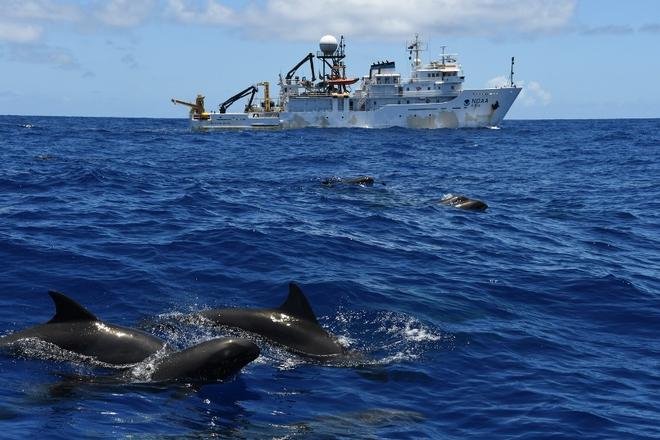High tech on the high seas
by NOAA Fisheries on 16 Nov 2017

Melon-headed whales surface near the NOAA Ship Oscar Elton Sette NOAA Fisheries
The Hawaiian Islands Cetacean and Ecosystem Assessment Survey is six-month mission to survey whales, dolphins, and seabirds around the Hawaiian Archipelago.
The goal is to estimate numbers of whales and dolphins in Hawaiian waters, examine their population structures, and better understand their habitats. This 187-day mission is a collaboration between the Pacific Islands Fisheries Science Center and the Southwest Fisheries Science Center aboard two NOAA Ships: the Oscar Elton Sette and Reuben Lasker. The study area spans the main and Northwestern Hawaiian Islands covering ~1.8 million square nautical miles. To find dolphins and whales in this vast survey region, our scientists use a range of different and new technologies.
Acoustic arrays
An acoustic array is used to “eavesdrop” and listen in on marine mammals underwater. The acoustic array consists of a series of hydrophones (underwater microphones) that are towed behind the ship. Because the array is towed, it is also called a towed array. Sounds recorded by the hydrophones are immediately transmitted back to the ship.
Scientists monitor the sounds by listening with headphones and watching a visual representation of the sounds known as a spectrogram because some sounds cannot be heard by the human ear. Using these two techniques, the acoustics team can determine when a vocalizing whale or dolphin is present and what species it is based on various characteristics of their sounds. Once animals are detected, the time difference of sound arrival to the hydrophones is used to locate and track the cetaceans as they move.
High-Frequency acoustic recording packages
We also monitor the sounds of whales and dolphins over long periods of time with long-term acoustic recorders deployed for months to years in specific areas. High-frequency Acoustic Recording Packages record a very broad frequency range allowing us to monitor the occurrence of all vocal species for more than a year. We maintain a passive acoustic network with HARPs at several long-term monitoring sites.
Drifting autonomous spar buoy recorders
Autonomous stationary acoustic recorders have been broadly used to understand the distribution and seasonality of cetaceans throughout the world’s oceans. We maintain a network of seafloor-anchored passive acoustic listening stations to listen for cetaceans and understand ocean noise. During the survey, we use a new type of free-floating autonomous recorder, the DASBR, to listen for cetaceans throughout the main Hawaiian Islands. DASBRs are designed with two hydrophones forming a short vertical array at ~150m depth that allows for computing the depth and distance of the sound source.
With these measures, we can determine how far the vocal animals are from DASBR, and the collection of those measurements may allow us to estimate the abundance of the species we’re acoustically detecting. Because the instruments are drifting, we can deploy them without regard to bottom depth, and we can sample an area in a more random and representative way than is possible with bottom-mounted stationary recorders. We track the instruments movements using Iridium satellite locators.
Although our primary goal is to estimate abundance of deep-diving whales, DASBRs record across a broad frequency range that will enable to us to detect the occurrence of most cetacean species, from baleen whales to the highest frequency delphinid sounds.
Hexacopters
To collect high-resolution aerial photographs of cetaceans, we fly a hexacopter from the NOAA ship or a small boat. The hexacopter is a remote-controlled, unmanned aerial vehicle with six propellers and a high-resolution camera. The images are used to evaluate reproductive output, by quantifying the proportion of adult females with calves in a group, and individual size and body condition, by taking photogrammetric measurements of individual length and width.
Target species for hexacopter operations include false killer whales, short-finned pilot whales, sperm whales, and Bryde’s whales, although flights may be made during sightings of rare and high profile species, such as killer whales, blue whales, and North Pacific right whales, in order to maximize the information gained from such unique opportunities.
If you want to link to this article then please use this URL: www.sail-world.com/158843